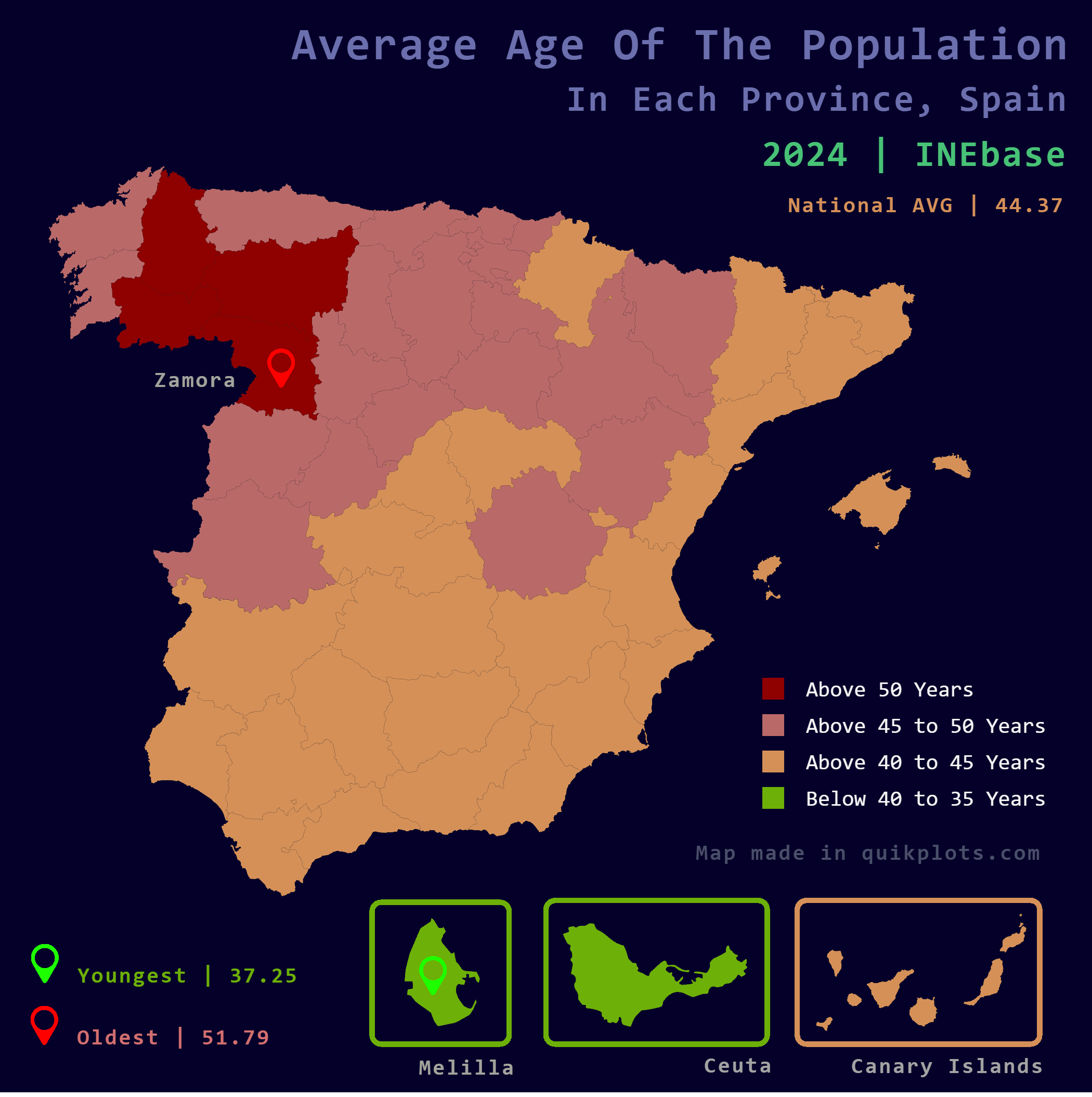Average Age of Population in Spain Provinces Map


David Chen
Data Visualization Specialist
David Chen is an expert in transforming complex geographic datasets into compelling visual narratives. He combines his background in computer science ...
Geographic Analysis
What This Map Shows\nThis map provides a visual representation of the average age of the population across various provinces in Spain for the year 2024. The data reveals critical insights into demographic trends, illustrating how age distribution varies significantly from one province to another. The national average age is noted at 44.37 years, which serves as a benchmark to understand the local variations. Notably, four provinces—Lugo, Leon, Orense, and Zamora—exceed an average age of 50 years, indicating a trend of aging populations in these areas. Conversely, the overseas territories of Ceuta and Melilla stand out with average ages below 40 years, highlighting a unique demographic landscape.
Deep Dive into Population Age Demographics\nThe average age of a population is a vital metric that reflects not only the current demographic makeup but also the socio-economic conditions of a region. In Spain, the aging population is becoming increasingly evident, influenced by various factors such as migration patterns, fertility rates, and healthcare advancements. Provinces with higher average ages often correlate with lower birth rates and an influx of older residents, whether through retirement or lifestyle choices.
Interestingly, the provinces exceeding the 50-year mark—Lugo, Leon, Orense, and Zamora—are predominantly located in the northwest of Spain, a region known for its rural landscapes and slower economic growth compared to urban centers. This aging trend can have profound implications, including labor shortages, increased healthcare costs, and shifts in economic activity as older populations require different services and amenities.
What's fascinating is that while regions like Lugo and Zamora are grappling with the challenges of an older demographic, Ceuta and Melilla present a contrasting scenario. These territories, due to their unique geographical and political contexts, boast youthful populations. The lower average age in these areas is likely influenced by higher birth rates and a younger immigrant population. This demographic dynamism illustrates how geography can shape population structures in diverse ways.
The economic implications of these demographic trends are significant. Regions with aging populations may face challenges in sustaining economic growth unless they adapt to the changing workforce dynamics. Conversely, younger regions like Ceuta and Melilla may experience economic opportunities driven by a vibrant, youthful workforce eager to participate in the economy. This duality highlights the importance of age demographics in planning for future infrastructure, services, and economic strategies.
Regional Analysis\nLet’s break down the provinces as seen on the map. Starting with the provinces with the highest average ages, Lugo’s average age of over 50 reflects its status as a province that has seen significant rural depopulation. This trend is often accompanied by a lack of job opportunities that encourage younger populations to migrate to urban areas. Similarly, Leon, Orense, and Zamora share similar stories of economic stagnation and aging populations.
On the other hand, Ceuta and Melilla serve as outliers in this demographic map. Their below-40 average ages indicate a burgeoning youthful demographic, which is critical for their economic vitality. The influx of young people into these territories has the potential to stimulate economic growth, especially in sectors like tourism and services, where a younger workforce can bring fresh ideas and energy.
The contrast between these regions also reflects broader national trends. Urban areas, particularly in and around major cities like Madrid and Barcelona, generally exhibit lower average ages due to high immigration rates and a concentration of job opportunities. These cities attract younger individuals seeking work and lifestyle options, which can significantly alter the demographic makeup of the surrounding provinces.
Significance and Impact\nUnderstanding the average age of the population in Spain’s provinces is crucial for multiple reasons. It informs policymakers about the potential needs of different regions, particularly in healthcare, education, and social services. As the population in provinces like Lugo and Zamora continues to age, the demand for elderly care services and healthcare infrastructure will increase.
Moreover, these demographic changes can influence economic strategies at both regional and national levels. Areas with older populations may need to rethink their economic models, focusing on attracting younger talent or adapting industries to cater to an aging workforce. On the flip side, regions with younger populations like Ceuta and Melilla might focus on harnessing this demographic advantage to foster innovation and entrepreneurship.
In conclusion, the average age of the population in Spain’s provinces is more than just a number; it is a reflection of the socio-economic landscape that requires careful consideration and action. As we move toward the future, understanding these demographic trends will be essential for sustainable development and policy-making in Spain.\n
Visualization Details
- Published
- October 13, 2025
- Views
- 30
Comments
Loading comments...